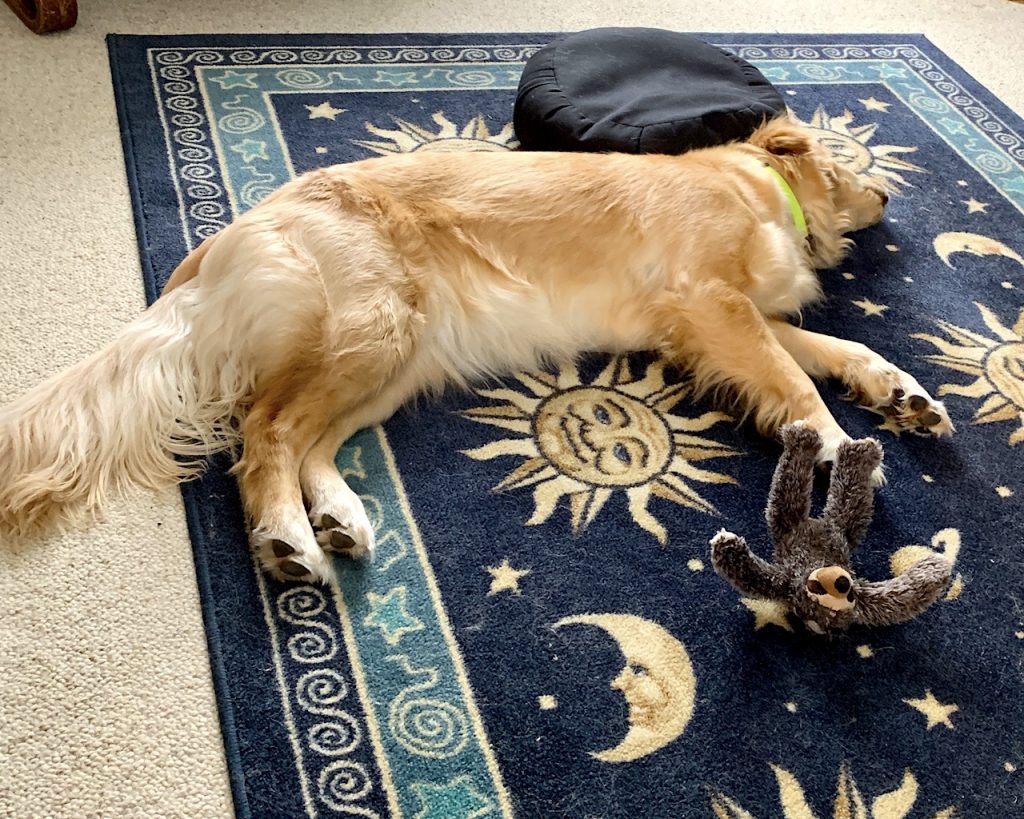Tag Archives: Meditation
1,000 Days
 I started keeping track of consecutive days on the (meditation) cushion on December 4, 2014. As of today, May 31, 2019, I’ve missed just two of the last 1,638 days. Today is the 1,000th consecutive day on the cushion. The only day that really counts, of course, is today. But I’ve found that logging my meditation practice helps me be consistent, something I do every day. And I can’t think of anything else I’ve done every day for 1,000 days.
I started keeping track of consecutive days on the (meditation) cushion on December 4, 2014. As of today, May 31, 2019, I’ve missed just two of the last 1,638 days. Today is the 1,000th consecutive day on the cushion. The only day that really counts, of course, is today. But I’ve found that logging my meditation practice helps me be consistent, something I do every day. And I can’t think of anything else I’ve done every day for 1,000 days.
I look forward to my daily meditation. I average 45 minutes a day but time really seems to stand still. One of my favorite things about the practice.
800 Days
 Yesterday was the 800th consecutive day on the cushion. I started meditating ten years ago but didn’t begin keeping a log of my daily practice until 2014. I’ve only missed two days in those four years. In all my reading about meditation there is general agreement it should be a daily practice. I sit for 30-45 minutes.
Yesterday was the 800th consecutive day on the cushion. I started meditating ten years ago but didn’t begin keeping a log of my daily practice until 2014. I’ve only missed two days in those four years. In all my reading about meditation there is general agreement it should be a daily practice. I sit for 30-45 minutes.
700 Days
I started meditating in 2008 but didn’t make it a regular (daily) part of my life until November 30, 2014. At least that is the date I started keeping track. Since then — as noted here previously — I have missed just two days, for a total of 1,343 days on the cushion. Today’s practice was 700 days without missing.
I sit for either 30 minutes or 45 minutes depending on what’s going on. I am a firm believer in making meditation a daily part of one’s life, if only 10 minutes.
I hope to share “1,000 Days” with you next year.
“Meditation is not about doing anything”
“Meditation is not about doing anything. It is simply paying attention.”
Not counting basic hygiene (brushing my teeth, etc), the only thing I do every day is meditate. I sit for 30 minutes, sometimes longer. Every day for the last 500 days. I keep track but I’m not sure that’s good idea. Too easy to get fixated on the streak, keeping the string going.
I’ve missed twice in the last 1,000+ days. Once when I was sick and again when out of town attending a high school reunion (#50). I’m not sure why I keep track of my practice. Maybe it’s for the same reason prisoners make marks on their cell walls (do they still do that?). They’re afraid they’ll forget how long the’ve been in prison? I’d rather think I keep track because it gives me a little added encouragement to sit, although I really don’t think I need that anymore. My daily meditation is the best half hour of my day. But why?
Steve Hagen says meditation is useless. The only reason to meditate is to mediate. Which sounds like something only those who meditate would say or understand. I’m sure when I started (10 years ago?) it was for stress management or relaxation or something but somewhere along the way it became an end in itself.
I find it simultaneously the simplest thing in the world and the most difficult. I’m sitting on a cushion on the floor, focused on my breath. What could be easier? And within seconds my mind has jumped to some random thought… I gently bring my awareness back to my breathing… and the cycle repeats, endlessly. Why would anyone invest half an hour every day doing this? Again, Steve Hagen: “At the heart of meditation is the intention to be awake.”
More excerpts from Meditation Now or Never by Steve Hagen.
Non-fiction in 2017
- Chaos: Making A New Science (James Gleick)
- Technocracy In America: Rise of the Info-State (Parag Khanna)
- Genius: The Life and Science of Richard Feynman (James Gleick)
- The Tao of Physics: An Exploration of the Parallels Between Modern Physics and Eastern Mysticism (Fritjof Capra)
- From Bacteria to Bach: The Evolutions of Minds (Daniel Dennett)
- Homo Deus: A Brief History of Tomorrow (Yuval Noah Harari)
- Isaac Newton (James Gleick)
- Why Buddhism is True: The Science and Philosophy of Meditation and Enlightenment (Robin Wright)
- WTF? What’s the Future and Why It’s Up to Us (Tim O’Reilly)
- Engines of Change: A History of the American Dream (Paul Ingrassia)
- Breaking the Spell: Religion As A Natural Phenomenon (Daniel Dennett)
Why Buddhism Is True
 The full title of this book is: Why Buddhism is True: The Science and Philosophy of Meditation and Enlightenment. And it’s the science and philosophy parts of the book that I found most insightful. There is so much within and about Buddhism that are really hard for me to grasp. Emptiness, non-self, just to mention two. This book gave me — for the first time — a tiny, brief glimpse of what these might be. The author explains how natural selection plays such an important role in determining who and what we are. And his explanation of consciousness is the best I’ve come across. This was a breakthrough book for me. I’ll be reading it again. Here are a few excerpts, stripped of all context. Continue reading
The full title of this book is: Why Buddhism is True: The Science and Philosophy of Meditation and Enlightenment. And it’s the science and philosophy parts of the book that I found most insightful. There is so much within and about Buddhism that are really hard for me to grasp. Emptiness, non-self, just to mention two. This book gave me — for the first time — a tiny, brief glimpse of what these might be. The author explains how natural selection plays such an important role in determining who and what we are. And his explanation of consciousness is the best I’ve come across. This was a breakthrough book for me. I’ll be reading it again. Here are a few excerpts, stripped of all context. Continue reading
Meditation: 365 Days
According to the app I use to track my meditation practice, today was the 365th consecutive day of sitting. Cool. One year with zero misses. Which means absolutely nothing other than I’ve been consistent in my practice. I started keeping track on November 30, 2014 and ran up a string of 371 days before missing a day (pneumonia). The next run — 271 days — ended while I was out of town attending my 50th high school reunion. Which might be the worst excuse imaginable. And now I’m less than a week away from beating that 371 string. Two days without meditating in the past 1,007 days.
The only day that counts, of course, is today. The app and keeping my streak alive give me a little extra incentive to sit every day but I don’t need much incentive these days. The time I spend in meditation is almost always the best part of my day.
Next milestone? 500 days.
Fear Hologram Projector
 The brain has the ability to generate vivid, life-like images and scenes. It does this seemingly on its own. These scenes can appear in one’s consciousness at any moment and they can be nearly indistinguishable from reality (‘out there’ as opposed to ‘in your head’). These thoughts, in my experience, are mostly beyond ‘our’ control. They happen to us. And while we can’t prevent them, we can — with practice — observe them. See them for what they are. The analogy that best captures this for me is a Fear Hologram Projector.
The brain has the ability to generate vivid, life-like images and scenes. It does this seemingly on its own. These scenes can appear in one’s consciousness at any moment and they can be nearly indistinguishable from reality (‘out there’ as opposed to ‘in your head’). These thoughts, in my experience, are mostly beyond ‘our’ control. They happen to us. And while we can’t prevent them, we can — with practice — observe them. See them for what they are. The analogy that best captures this for me is a Fear Hologram Projector.
“Fear” because the scenarios that trouble me most involve fear and worry and anxiety. “Hologram” because these little mental vignettes are so incredibly real. I don’t know why the brain (some brains) persists in creating these but the brain in my head pulls from a lifetime of images and situations and mashes them up with the most negative of emotions and ideas.
It’s like walking down one of the endless passages in my brain and suddenly finding myself in one of these holograms. And the more mental attention I give it, the sharper and more detailed it seems. The hologram seems to need the energy of my attention to project. The fear hologram can loop endlessly for days or weeks. Or longer.
The brain can, of course, create a more positive, pleasant scenario. We like to imagine good and happy things happening. It would seem to be just as easy to create that kind of hologram as the awful kind. If ‘I’ am going to imagine some future, why wouldn’t I choose to something pleasant? The only answer I can come up with is I don’t get to choose. These mostly just happen. They come unbidden.
How do we turn off the Fear Hologram Projector?
Well, we can’t turn it off until we recognize what’s happening. We can’t see the projector when we’re in the middle of the hologram loop. The key here is probably mindfulness. Seeing what is really occurring. Not in your head but in the real, objective world around you (if you believe in such a thing). We might think of this as “experiential reality.” What we see, hear, touch, smell, taste.
When I find myself trapped in a fear hologram, it feels dark, like a movie theater. The images on the screen are more vivid in a darkened theater. And I can’t see the projector because I don’t know to look for it, or where to look.
But if I can be mindful enough to recognize I’m in a hologram — something generated by a (I choose not to say ‘my’) mind — I can bring up the house lights of my awareness! And in that instant I can see that the images are not real. They’re brain stuff. Stuff ‘I’ didn’t choose. Under the bright light of my awareness, the hologram images fade and as my awareness stops powering the projector, the images disappear. My belief, my buy-in is necessary for the hologram to exist.
I’m reminded of lines from my reading about Buddhism and Taoism.
“Am I conscious now? It troubles me that I seem so often to be unconscious. I wonder what this unconsciousness is. I cannot believe I spend most of my life in a kind of darkness. Surely that cannot be so. Yet every time I ask the question it feels as though I am waking up, or that a light is switching on.” – Ten Zen Questions
“Belief is at best an educated, informed conjecture about Reality. In contrast, seeing — raw, direct, unadulterated experience — is the direct perception of Reality Itself. […] Base your actions on what you see, rather than on what you think.” – Buddhism Plain and Simple
The bad news: our brains (okay, fuck it! My brain) have an endless capacity for materializing FHP’s (Fear Hologram Projectors), twenty-four/seven. And a lifetime of material from which to create the loops. Access to all our fears and anxieties.
The good news: it’s pretty easy to hit the house lights, spot the projector and pull the attention plug. If we can stay mindful. Of course, mindfulness doesn’t necessarily mean a state of meditative bliss. If you’re rocketing down a black ski slope; lining up for a night landing on an aircraft carrier; or in the middle of brain surgery… you’re probably not trapped on some mental fear loop. And lots of daily, less challenging tasks, can help us stay in the moment. But the mind never stops. You can hit the house lights and pull the plug on the fear projector… and find yourself back in some anxious future 30 seconds later. And this can repeat over and over, day and night.
At the risk of oversimplifying, I am either ‘awake’ or not-awake. Not-awake can take several forms, of course. There the subconscious which is probably what I’ve been talking about. How frustrating that it handles all of those life and death tasks (breathing, heart, etc) without any help from the conscious me…. and still finds time to gin up endless fear and anxiety scenarios.
Then there are dreams — which tend to be more real than the Fear Holograms — but there’s nothing we can do about those. Fortunately, mine seem to fade quickly upon awakening. And I’ve read that we also experience unconsciousness most nights. Dreamless sleep. Would like to have more of that.
I expect to be reaching for the switch to the house lights for the rest of my life. Endlessly pulling the plug on the FHP. But I find some comfort in the belief that “Thoughts think themselves.” I don’t control them. That’s the subconscious, forever and always.
And I have the cushion. Meditation. Observing the mind, allowing it to become quieter (rarely quiet). Awakening, if only for a moment.
Meditation can ‘reverse’ DNA reactions
“Lead investigator Ivana Buric from the Brain, Belief and Behaviour Lab in Coventry University’s Centre for Psychology, Behaviour and Achievement said: “Millions of people around the world already enjoy the health benefits of mind-body interventions like yoga or meditation, but what they perhaps don’t realise is that these benefits begin at a molecular level and can change the way our genetic code goes about its business.
The research, published today in the journal Frontiers in Immunology, reviews over a decade of studies analysing how the behaviour of our genes is affected by different MBIs including mindfulness and yoga. […] When examined together, the 18 studies — featuring 846 participants over 11 years — reveal a pattern in the molecular changes which happen to the body as a result of MBIs, and how those changes benefit our mental and physical health.

